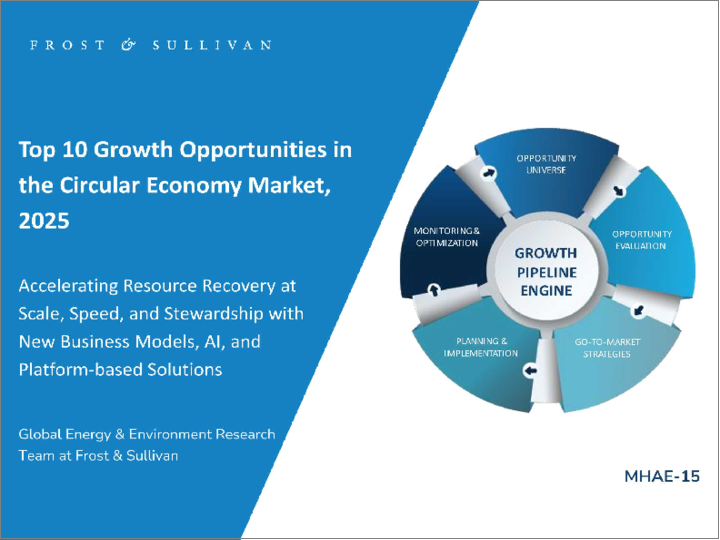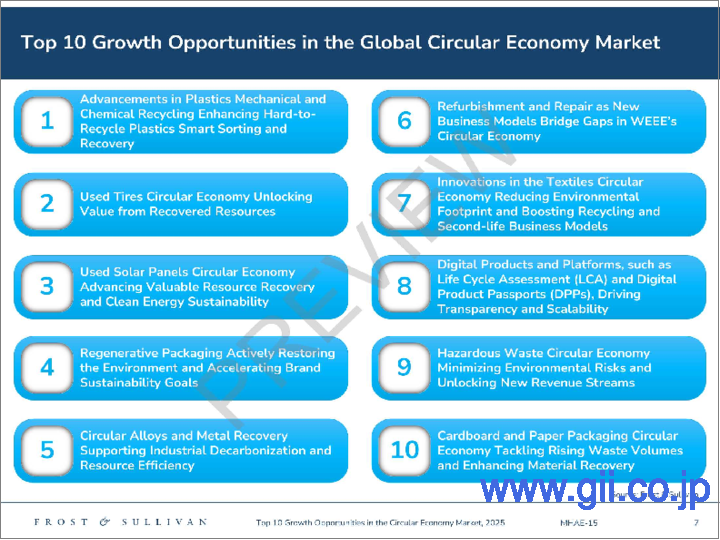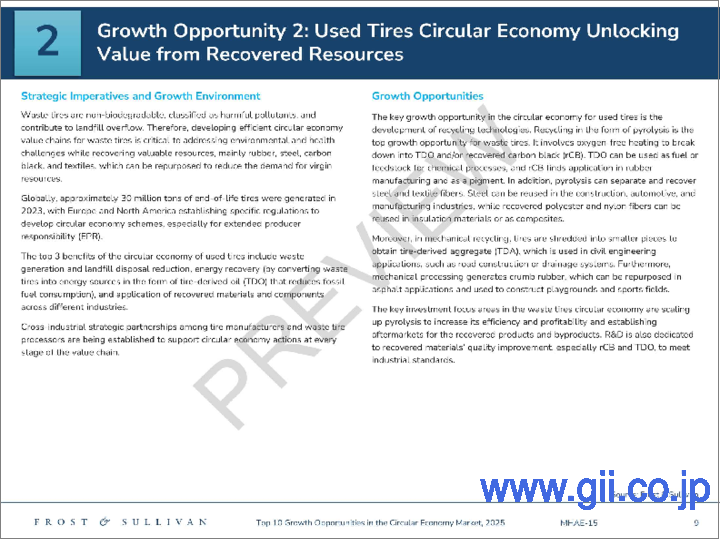|
|
市場調査レポート
商品コード
1691680
サーキュラーエコノミー(循環型経済)市場における成長の機会トップ10:2025年Top 10 Growth Opportunities in the Circular Economy Market, 2025 |
||||||
|
|||||||
| サーキュラーエコノミー(循環型経済)市場における成長の機会トップ10:2025年 |
|
出版日: 2025年02月18日
発行: Frost & Sullivan
ページ情報: 英文 18 Pages
納期: 即日から翌営業日
|
- 全表示
- 概要
- 目次
サーキュラーエコノミー(循環型経済)市場は、材料回収とリサイクルプロセスを改善する技術とソリューションの進歩により、2025年に大きく成長する見通しです。高度な材料認識と選別のためのAIベースのロボットシステム、マテリアルフローを追跡するためのプラットフォームベースのソリューション、可視性と効率を高めるエンドツーエンドのデータ分析に主要な機会が出現しています。これらのテクノロジーは、持続可能性を高め、資源の循環性を改善し、リサイクルと材料回収施設のオペレーションを最適化します。サプライチェーンのデジタル化は、業界を横断する材料調達を加速し、包装廃棄物、リサイクル困難なプラスチック、電子廃棄物、繊維製品、タイヤ、ソーラーパネル、有害廃棄物など、重要な材料の流れのためのリバース・ロジスティクスを強化します。このような素材の流れは、サーキュラー・トランスフォーメーションの可能性があるため、投資を集めています。さらに、先進技術の活用は、資源回収事業の生産性、透明性、収益性を高め、新たなビジネスモデルを創出し、材料調達効率を最大化します。
組織化された資源回収ネットワークを開発し、効率的な資源の流れを確保するには、業界内の戦略的パートナーシップと垂直統合が不可欠です。
当レポートでは、プラスチックのリサイクル、使用済みタイヤやソーラーパネルの回収、再生可能なパッケージング、ライフサイクルアセスメント(LCA)やデジタル製品パスポート(DPP)などのデジタル・プラットフォームなど、循環型経済分野における成長の機会を特定しています。また、各業界の成長を牽引する最前線の企業である「成長加速企業」にもスポットを当てています。これらの企業は、持続可能な循環型経済への移行の最前線に位置し、常に進化し続ける顧客ニーズに対応するために、新しい技術、ソリューション、プラットフォーム、ビジネスモデル、戦略を創造し、絶えず革新を続けています。本調査では、2025年以降のサーキュラーエコノミー市場における投資機会に影響を与える上位10動向を分析します。
目次
2025年の主要な成長の機会
- 戦略的インペラティブ
- ESG、持続可能性、循環型経済の未来に向けた6Pフレームワーク:ネットゼロへの道
- 世界の循環型経済市場における成長の機会トップ10
- 成長の機会1:プラスチックの機械的および化学的リサイクルの進歩リサイクルが困難なプラスチックのスマートな選別と回収の強化
- 成長の機会2:使用済みタイヤの循環型経済回収された資源から価値を引き出す
- 成長の機会3:使用済み太陽光パネル循環型経済による貴重な資源回収とクリーンエネルギーの持続可能性の推進
- 成長の機会4:環境を積極的に回復し、ブランドの持続可能性目標を加速する再生型パッケージ
- 成長の機会5:産業の脱炭素化と資源効率化を支援する循環型合金と金属回収
- 成長の機会6:WEEEの循環型経済のギャップを埋める新しいビジネスモデルとしての改修と修理
- 成長の機会7:繊維循環経済におけるイノベーション環境フットプリントの削減とリサイクルおよびセカンドライフビジネスモデルの促進
- 成長の機会8:LCAやDPPなどのデジタル製品とプラットフォーム別透明性と拡張性の推進
- 成長の機会9:有害廃棄物循環型経済環境リスクを最小限に抑え、新たな収益源を開拓
- 成長の機会10:段ボールと紙の包装循環型経済増加する廃棄物量への取り組みと材料回収の強化
- 免責事項
Accelerating Resource Recovery at Scale, Speed, and Stewardship with New Business Models, AI, and Platform-based Solutions
The circular economy market is poised for significant growth in 2025, driven by advancements in technologies and solutions that improve material recovery and recycling processes. This study analyzes the top 10 trends impacting investment opportunities in the circular economy market in 2025 and beyond. Key opportunities are emerging in AI-based robotic systems for advanced material recognition and sorting, platform-based solutions for tracking material flow, and end-to-end data analytics to enhance visibility and efficiency. These technologies will boost sustainability, improve resource circularity, and optimize operations at recycling and material recovery facilities. Supply chain digitalization is accelerating cross-industry material sourcing, which enhances reverse logistics for critical material streams, such as packaging waste, hard-to-recycle plastics, eWaste, textiles, tires, solar panels, and hazardous waste. These material streams are attracting investments due to their potential for circular transformation. In addition, using advanced technologies will increase resource recovery operations' productivity, transparency, and profitability, creating new business models and maximizing material sourcing efficiency.
Strategic partnerships and vertical integration in industries are vital to developing organized material recovery networks and ensuring efficient resource flows. Frost & Sullivan's Sustainability Program identifies top growth opportunities in circular economy sectors, including plastics recycling, used tires and solar panel recovery, regenerative packaging, and digital platforms, such as life cycle assessments (LCA) and digital product passports (DPPs). The study also highlights top Growth Accelerators-companies at the forefront of driving growth in their respective industries. These companies continuously innovate by creating new technologies, solutions, platforms, business models, or strategies to serve ever-evolving customer needs, positioning themselves at the forefront of the transition to a sustainable, circular economy.
Table of Contents
Top Growth Opportunities for 2025
- Strategic Imperatives
- The 6P Framework for the Future of ESG, Sustainability, and Circular Economy: A Pathway to Net Zero
- Top 10 Growth Opportunities in the Global Circular Economy Market
- Growth Opportunity 1: Advancements in Plastics Mechanical and Chemical Recycling Enhancing Hard-to-Recycle Plastics Smart Sorting and Recovery
- Growth Opportunity 2: Used Tires Circular Economy Unlocking Value from Recovered Resources
- Growth Opportunity 3: Used Solar Panels Circular Economy Advancing Valuable Resource Recovery and Clean Energy Sustainability
- Growth Opportunity 4: Regenerative Packaging Actively Restoring the Environment and Accelerating Brand Sustainability Goals
- Growth Opportunity 5: Circular Alloys and Metal Recovery Supporting Industrial Decarbonization and Resource Efficiency
- Growth Opportunity 6: Refurbishment and Repair as New Business Models Bridge Gaps in WEEE's Circular Economy
- Growth Opportunity 7: Innovations in the Textiles Circular Economy Reducing Environmental Footprint and Boosting Recycling and Second-life Business Models
- Growth Opportunity 8: Digital Products and Platforms, such as LCA and DPPs, Driving Transparency and Scalability
- Growth Opportunity 9: Hazardous Waste Circular Economy Minimizing Environmental Risks and Unlocking New Revenue Streams
- Growth Opportunity 10: Cardboard and Paper Packaging Circular Economy Tackling Rising Waste Volumes and Enhancing Material Recovery
- Legal Disclaimer






